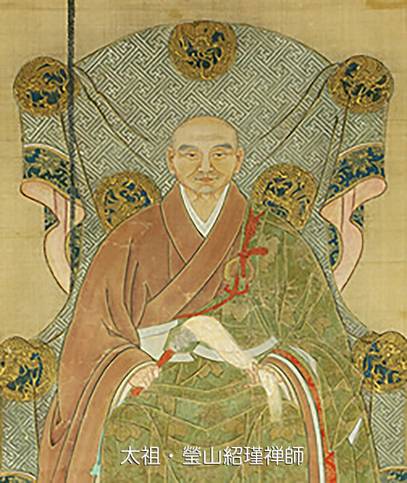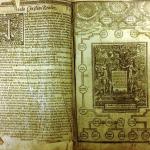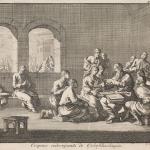In this post
I’ll offer some dharma gems from Keizan Jōkin Zenji (1268–1325), the fourth generation in the Sōtō succession in Japan. Keizan is regarded as the second founder of Japanese Sōtō and is also known as Taiso Jōsai Daishi. This is part of a series in which I’m highlighting some of the background and teaching on the ancestors in the Sōtō lineage before and after Dōgen in order to put his teaching in context.
As for this post, first, just for some background, you’ll find a biography of Keizan that appears in Thomas Cleary’s Timeless Spring: A Soto Anthology, a highly recommended resource for all Zen students.
Then the main thing that I’m very excited to share here: Answers to Ten Questions from the Emperor by Keizan Jōkin Zenji. This is an extraordinary text and culminates with the Emperor asking Keizan for advice for his work with the mu kōan. He’s been working on it for just a year and is a bit whiney about not having yet plunged to the depths of the buddhadharma yet. So read through (or scroll) to question 10!
Keizan responds to the Emperor by quoting Dahui’s advice for the keyword method. In fact, 3/5s of Keizan’s response is quoting Dahui – yup, I did the word count. Now, do you suppose you would give advice to the Emperor about something if you didn’t feel really competent and confident in what you were recommending? The implications of this and the whole text, really, for our understanding of Sōtō Zen in the medieval period are profound and far-reaching.
More on that later.
Answers to Ten Questions from the Emperor was translated by Kokyo Henkel, a wonderful American Sōtō teacher, a successor of Tenshin Anderson Rōshi. In addition, Kōkyō is an excellent translator and generously shared this translation with Wild Fox Zen. Kōkyō’s work succeeds at staying close to the Chinese characters while at the same time flowing well in English. This is no small thing.
You can read more about Kōkyō here.
Kōkyō’s website includes an enormously rich array of dharma resources. It’s one of my go-to sites. If you are interested in buddhadharma, check it out and I bet you’ll find something important for your path. I’m grateful for Kōkyō’s years of training that make the resource possible, as well as his generous heart that makes it available.
For example, you can also find a pdf version of Answers to Ten Questions from the Emperor that is included in this post here. You’ll also find ”Yongjia’s Verse Giving Rise to the Vow” (“Yongjia Zhenjue’s Hotsuganmon”) also recently translated by Kōkyō here. Yongjia is also known as “The Overnight Guest” due to his receiving transmission from the Sixth Ancestor, Huineng, after spending just one night at his monastery. Yongjia is better known for his “Song of Enlightenment.” Finally, you can find the “Secrets of the Zen Precepts” by Manzan Dohaku (1636–1714) here. Manzan was an important link in the Sōtō transmission.
None of these gems has been available before in English, as far as I know.
Enjoy!
Keizan’s Biography from Timeless Spring
The Zen master’s initiatory name was Jokin; he was styled Keizan. He was entitled Zen Master with Enlightened Compassion; this was a posthumous title granted by the emperor of the southern court.
He was from Etchu, and his lay surname was Kubara. When he was a child he took master Ejo as his teacher and shaved his head and put on monk’s clothing. When Zen master Gikai succeeded to the seat to lead the community at Eihei, the master Jokin served as Gikai’s personal attendant, taking care of his robes and bowl.
One time when he entered Gikai’s room, Gikai asked him, “Can you bring forth the ordinary mind?” As Jokin tried to say something, Gikai hit him right on the mouth; Jokin was at a loss, and at this point his feeling of doubt blazed. One night as he was in the hall sitting in concentration, he suddenly heard the wind at the window and had a powerful insight. Gikai deeply approved of him. After a long time Gikai entrusted the teaching to Jokin, who finally succeeded to the seat at Daijo, having had for years the complete ability, transcending the teacher.
When he reopened the Eiko monastery of eternal light and lived there, lords and officials came to him when they heard of him; his influence was greatest in his time. One day he said to his student Meiho, “On the spiritual mountain there was a leader of the assembly (Mahakasyapa) who shared the teaching seat (with Shakyamuni Buddha); at Caoqi there were leaders of the assembly who shared the teaching. Here at Eiko today I too am making an assembly leader to take part in the teaching.”
Then with a verse he bestowed the robe — “The flaming man under the lamp of eternal light – shining through the eon’s sky, the atmosphere is new. The putting Peak of Brilliance [this refers to Meiho] is hard to conceal; his whole capability turns over, revealing the whole body.”
Thereafter the master Jokin never drummed his lips (spoke much) to the assembly; late in life he changed the disciplinary monastery Soji into a zen place and stayed there. After a long time at it, he had had enough of temple business, so he gave the abbacy to Gazan, extending a collateral branch of the teaching. The master Jokin always liked to travel, so when he had retired from his duties he wandered around with a broken rainhat and a skinny cane, meeting people wherever he went, and crowds of people submitted to him.
Answers to Ten Questions from the Emperor
Jushū Chokubun Sōtaishū
by Keizan Jōkin Zenji
十種勅問奏對集
“Ten Item Imperial Questions and Reported Answers Collection” (1)
Written Questions of Emperor Godaigo, answered by Keizan Jōkin in 1320/22
Presented by Hōun Fugai Zenji (a.k.a. Azakami Baisen 1825-1901),
recorded by his jisha Taisho Tripitaka Volume 82, number 2588
Translated by Kōkyō Henkel, 2021
- The Emperor asked: Zen Ancestors’ thought and [Tendai and Shingon] Teaching Schools’ thought, are they the same or different?
Teacher Keizan replied: The Zen Ancestors and the Teaching Schools are like water and waves; how could they be different? However, many Teaching School people are bound in the net of the teachings without being able to get free. From ancient times up to the present, when meeting with the Zen Ancestors’ thought, many people have attained their aim.
Elder Fu of Taiyuan City [in China], having recently become abbot of Guangxiao Temple in Yangzhou City, was lecturing on the Nirvana Sutra. One Zen person, taking shelter from a snowstorm, was staying at the temple, so he went to listen to the lecture. The abbot was teaching on the three causes of buddhanature and the three virtues of the dharma-body. He taught extensively about the dharma-body and its wondrous principle, but the Zen person was laughing during the lecture. After finishing the lecture, the abbot invited the Zen person to tea and said to him, “I am a simple person with limited inferior knowledge, so I rely on the text for understanding. I saw that you were laughing at me, but which part of my talk was lacking? I humbly wish to understand the teaching.”
The Zen person said, “Since you ask, I laughed because you don’t know the dharma-body.”
The abbot said, “My explanation was thus; what was lacking in it?”
The Zen person said, “Will the abbot please explain again?”
The abbot said, “The dharma-body’s principle is like great space, pervading the three times and all ten directions, including the eight extremities and two modes, according with conditions and responding without limit.”
The Zen person said, “I don’t say that your lecture was not correct, but you only explain the dharma-body’s measurable qualities. In fact, you don’t yet know the dharma-body.”
The abbot said, “If you say so, Zen person, please explain it to me now.”
The Zen person said, “Do you not trust me?”
The abbot said, “How could I dare not trust you?”
The Zen person said, “If so, practice thus: temporarily stop lecturing. For ten days, stay in a room, practice upright sitting, gather mindfulness, collect the mind (sesshin); good, evil, and all involvements will be cast off at once, and the abbot will be released from relying on the teachings.”
The abbot sat from the afternoon [of the tenth day, through the night], and in the early morning during the fifth watch, he heard the sound of the drum and clearly realized enlightenment. [Later he became a disciple of Xuefeng.] (2)
So it is, so it is.
Also, Abbot Liang of West Mountain [in China] met Mazu. Mazu asked, “What sutras do you teach?”
Liang said, “The Heart Sutra.”
Mazu asked, “How do you teach it?”
Liang said, “I use the heart to teach.”
Mazu said, “The heart (mind, chitta) is like a main actor, thought (manas) is like a supporting actor, the six consciousnesses (vijnana) are like assistants [as taught in the Lankavatara Sutra]. How can they understand your teaching of the sutra?”
Liang said, “If the heart can’t teach it, then does empty space teach it?”
Mazu said, “Empty space teaches it.”
Liang shook out his sleeves and began to leave. Mazu called to Liang, Liang turned his head, and Mazu said, “What is it?”
Liang brightly opened to great awakening.
So it is, so it is.
Also, Great Teacher Yongjia [Tiantai and Chan monk], Guifeng Zongmi [Huayan and Chan monk], Abbot [Shouzhou] Liangsui [disciple of Mayu Baoche], and Changshui [Zhixuan, Tiantai and Chan monk], as well as the two transmitters of the teaching to Japan, Dengyō Daishi [Saichō, founder of Tendai] and Kōbō Daishi [Kūkai, founder of Shingon], all practiced the Ancestral Teachers’ Zen and attained the seal of verification. Is this not excellent beyond measure?
-
- The Emperor asked: Bodhidharma’s fragrance arrived, as the third son of an Indian king. However, the four great elements and five aggregates make up the body, so how did Bodhidharma travel [across the Yangzi River] on one reed stalk?
Teacher Keizan replied: All buddhas and all ancestors cannot possibly conjecture about such mystical powers and wondrous function. Going beyond ordinary feelings, one may lean towards Buddha-Dharma’s spiritual mysticism. Even though Bodhidharma’s fragrance arrived as the king’s child, this is the precious Avalokiteshvara Mahasattva’s transformation body (nirmanakaya). How could there possibly be no mystical powers and wondrous function, even though such things are inferior to the ancestral teacher’s gate? Also, mystical powers and wondrous functions are not strange or special. As Layman Pang said, “Mystical powers and wondrous function: carrying water and chopping wood.”
- The Emperor asked: The Zen School is said to not rely on words and letters, but is a teaching outside the scriptures, a separate transmission. And yet the whole great sutra storehouse (tripitaka) is all words and letters. The Zen School’s records of sayings are also words and letters. If there were no words and letters, how would the buddhas and ancestors speak and teach? What can we rely on to transmit the teachings in this age of decline?
Teacher Keizan replied: Words and letters are like traps and snares for catching fish and rabbits. Yet traps and snares can be used if one doesn’t get confused. Sutra teachings are like a finger pointing at the moon. If one sees the moon, then the finger has no use. Thus, everyone knows that traps and snares do not attain fish and rabbits, and they know that the finger does not see the moon. The ancients’ speech was not established on words and letters. The World-Honored One’s forty-nine years of vertical expounding and horizontal expounding has been left behind for us; however, the Buddha picked up one flower and showed it to the assembly, and the assembly remained silent. Only Venerable Kashyapa’s face broke into a smile. This is not established on words and letters; it is a separate transmission outside the teachings. This is the supreme presentation.
- The Emperor asked: We have a so-called body of four great elements which deceptively combine; at the end of our lifespan, the earth element returns to earth, the water element to water, the fire element to fire, the wind element to wind. So then, what thing falls into hell?
Teacher Keizan replied: When the lifespan ends, there is the view that the four great elements separate and disperse, and there is not one thing left. Those outside the Way have such a view of emptiness. Actually, cause and effect play out endlessly; understand this view. Depending on this life, good and evil karma are the cause for receiving and depending on a body in the next life: perhaps life in a heaven, perhaps entering a hell realm, hungry ghost realm, or animal life, receiving the seeds of suffering. All sutras say these words clearly. Likewise, a person attaining great liberation is able to speak of no hell and no heaven.
- The Emperor asked: Everyone acts to bring benefit to their deceased father and mother. We prepare offerings of tea and hot water for their spirits but, even if there are just a few offerings, they don’t vanish. How can we know if they receive our offerings or not?
Teacher Keizan replied: This is like a bee collecting nectar from flowers; it receives only the taste without diminishing the flowers’ color and fragrance. How could these things vanish? Moreover, it is said in the [Abhidharma]-kosha, in the Chapter on “The World,” that those in the middle existence [between two lifetimes, antarabhava], take fragrance for food, relying on the food of scents; they are called gandharvas. Thus, those with few blessings receive only the food of bad smells, and those with many blessings receive the food of exquisite scents. So it is, so it is.
- The Emperor asked: The World-Honored One practiced in the snow mountains (Himalaya) for six years. When the morning star appeared, he suddenly realized great awakening. He said “I, together with the great earth and all sentient and insentient beings, now attain the Way.” A realized person clearly attains the Way, but how does a deluded person attain the Way?
Teacher Keizan replied, The [Complete Awakening] Sutra says, “Know that sentient beings originally have attained buddha.”
So it is, so it is.
Sentient beings already originally have it, but even though they are endowed with buddha-nature, they use it without knowing it. Old Master Shakyamuni attained the Way, completely opening the lively eye of insight. Thus grass, trees, lands, everything, and everyone attained buddha.
The Sixth Ancestor said, “awakened, sentient beings are buddha. Deluded, buddha is a sentient being.” (4)
Beings and buddhas are originally not separate. Delusion is because of sentient beings. Awakening is because of buddhas. How can sentient beings, if not deluded, be separate from buddhas? In ancient times there was the Buddha’s forty-nine years of expounding Dharma, saving deluded sentient beings, causing them to see originally existing buddha-nature.
- The Emperor asked: The Diamond Sutra says, “All buddhas and the Dharma of anuttara-samyaksambodhi of all buddhas originate from this sutra.” [section 8] The Diamond Sutra is Shakyamuni Buddha’s teaching, but it is said that all buddhas originate from this sutra. Not knowing this sutra previously, how did all previous buddhas follow it?
Teacher Keizan replied: The sutra teaches with one word, constantly teaching Dharma. This Dharma is itself the principle. This Dharma principle accompanies heaven and earth before any separation. All previous buddhas emerge from this. Clearly passing through, merging with this Dharma principle, is what makes all buddhas. Violating this Dharma principle is what makes ordinary people. Benevolent ones are called benevolent. Knowing ones are called knowing. Anuttara-bodhi (unsurpassed awakening) is also like this!”
- The Emperor asked: The [Lotus] Sutra says, “Great Pervading Wisdom Victor Buddha sat at the site of awakening for ten kalpas, while Buddha-Dharma did not manifest, and he did not attain the Buddha-Way.” So it is, so it is. How can present-day people practice zazen for one lifetime and attain the Buddha-Way?” (5)
Teacher Keizan replied: Great Pervading Wisdom Victor Buddha sat at the site of awakening for ten kalpas, and even then Buddha-Dharma did not manifest, and he did not attain the Buddha-Way. Within the teaching, one must teach with discerning knowledge. Great Pervading Buddha, because of his great courageous and bold spirit, advanced with power. The sutra’s “ten kalpas” is like the time it takes to eat a meal. If present-day people just have the root of great trust, then ten kalpas are not a long time. Thus, within the ancestral teachers’ gate, it is inferior to separate from this lifetime.
Teacher Linji said, “‘Great Pervading’ means that one personally arrives at the place of ten-thousand dharmas being without nature and without characteristics. This is called ‘Great Pervading.’ ‘Wisdom Victor’ is being without doubt in every place, and not attaining a single dharma. This is called ‘Wisdom Victor.’ ‘Buddha’ means the mind of pure radiant light, penetrating and pervading the dharmadhatu. This is called ‘buddha.’ ‘Ten kalpas sitting at the site of awakening’ is the ten paramitas. ‘Buddha-Dharma not manifesting’ is Buddha originally not arising and Dharma originally not ceasing. How could it manifest! ‘Not attaining the Buddha-Way’ is Buddha’s not becoming Buddha again.” (6)
So it is, so it is.
That’s how to rely on the sutra’s words, being released above, and Linji’s saying, shifting the meaning below. See this, even though it is difficult to understand!
- The Emperor asked: The [Manjushri-Pariprccha, Prajna Paramita in 700 Lines] Sutra says, “Pure practitioners do not enter nirvana; monks who break the precepts do not enter hell.” However, pure practitioners may enter nirvana; how could they not enter? Monks who break the precepts may enter hell; how could they not enter?
Teacher Keizan replied: There is the view of nirvana and hell remaining as two; in the small vehicle this view is understood. In reality, good and evil are nondual, harmful and upright are one suchness.
Discussing what is purity when breaking precepts, the Complete Awakening Sutra [Chapter 6] says, “Sentient beings and worlds have the same one dharma-nature; hells and heavens are both pure lands. All afflictions are complete liberation.”
So it is, so it is.
Thus, there is no nirvana to possibly seek, no hells to possibly reject. This is how we can we discuss the purity of breaking precepts.
- The Emperor asked: I’ve been taking up Zhaozhou’s “No” koan for a year but still I have not passed through and penetrated the root. How can I make effort (gongfu) in using the mind?
Teacher Keizan replied: You have come to ask these imperial questions; this is the exceedingly best conduct. In the past, one “drew feet on a snake” [Chinese idiom: gilded the lily] – in a strong explanation for laying the foundation, Zen Teacher Dahui [in his Letters, section 10.5] said:
“A monk asked Zhaozhou, ‘Does a dog have buddha-nature or not?’ Zhou said ‘No.’ This one word destroys and eliminates lots of harmful knowing and bad awakening, [being stuck] underneath a bowl. It is not attained by understanding ‘there is’ or ‘there isn’t.’ It is not attained by understanding through reasoning. It is not attained by using the faculty of thought (manas), thinking, or conjecture. It is not attained by raising the eyebrows and blinking the eyes. It is not attained through the path of [the ancestors’] words, or using lively strategies. It is not attained by abiding in non-doing inside a shell. It is not attained by raising it up and abiding in it, inheriting it or taking charge of it. It is not attained by pulling out proof from words and letters. Just, throughout the twelve hours, within the four dignified postures (sitting, standing, walking, reclining), constantly take it up. Constantly raise it up and awaken to: ‘Does a dog have buddha-nature or not? No.’ Do not separate from this throughout the day. Thus, work hard (gongfu) to investigate. ‘In a month or ten days’ [Chinese idiom for ‘quickly’] you will see and attain it.”
So it is, so it is.
Once more, does a dog have buddha-nature or not? Zhou said “no.” This one word is an easy way to destroy birth and death, a knife to cut through the bottom of the doubting mind. Take hold of this knife handle. Only taking charge of it like this, can one put it in one’s own hand. With just the written teachings, a person is separate from it, with an unskilled hand, and doesn’t attain it. One must go straight to one’s own home; only then can an unskilled hand begin to attain it. Once more, [Dahui, in his Letters, section 58.2] said:
“It is not attained by understanding it like the spark from a flint stone, or a flash of lightning. Straightaway attain no more place to use the mind; when the mind has no more place, do not be afraid of falling into emptiness. Here, retreating within is an excellent place. Suddenly ‘the old mouse enters into an ox horn’ [Chinese idiom: all tricky methods will be cut off]. It will be easy to see, topple over, and cut off.”
So it is, so it is.
This is my hidden wish. Under the Emperor’s throne there are ten-thousand functions, as well as excess leisuretime. Throughout the twelve hours, raise it up. Holding up the keyword (huatou) is the superior way to break through doubt; then a thousand doubts, ten-thousand doubts are broken through at once. At that time, you will penetrate and verify the original ground, wind, and light, and the original face will certainly be seen. Many prayers for happiness, many prayers.
- From Sōtō Zen in Medieval Japan by William Bodiford p. 101: “Sōjiji possesses a list of ten questions that Godaigo supposedly submitted to Keizan at Sōjiji in 1322. Sōjiji tradition claims that in return for Keizan’s satisfactory responses Godaigo made Sōjiji the head temple of the Sōtō school later that same year. In opposition to Sōjiji, however, Yōkōji possesses its own version of Godaigo’s ten questions that (in their version) were sent to Keizan at Yōkōji in 1320—two years earlier than claimed by Sōjiji. Moreover, Yōkōji tradition claims that Godaigo responded to Keizan’s answers by making Yōkōji the head temple of the Sōtō school in 1321. Few other documents are as blatantly false as these, but even texts that are generally reliable might not convey all of the details with complete accuracy.”
- This story also appears in the commentary to Hekiganroku case 99.
- This story also appears in Dōgen’s Shōbōgenzō Kokū.
- Section 52 of Platform Sutra.
- This story appears in “The No Gate Barrier” (Japanese, Mumonkan), Case 8.
- This saying appears in Record of Linji (Japanese, Rinzai-roku) Section 2.












